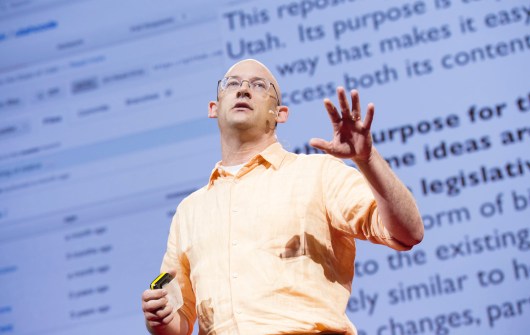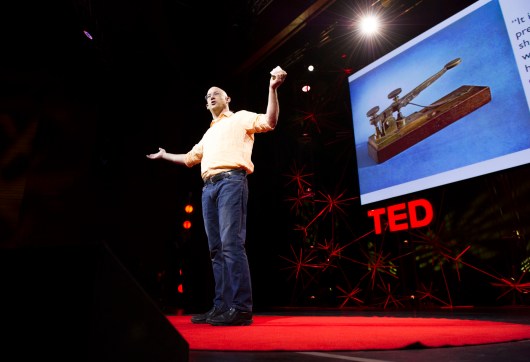Amy Cuddy must be proud: Clay Shirky walks on stage and promptly strikes a power pose. Then he tells us of a 9-year-old Scottish girl who lives about 50 miles from here. Martha Payne started the foodblog NeverSeconds, for which she took her camera into school to document her lunches, using metrics such as “pieces of hair found in food.” First, she acquired dozens, then hundreds, then thousands of readers. Until, two weeks ago, when she posted that she’d been shut down by her head teacher. No more photos from the lunch room.
“You can guess what happened next,” says Shirky to laughs and applause. “The outrage was so swift, so voluminous, so unanimous that the council reversed itself the same day. ‘We would never censor a 9-year-old,’ they said. Except for this morning.” Shirky asks the obvious question: “What made them think they could get away from this?” The answer is simple: “all of human history prior to now.”
Now, a history lesson to track what happens when a medium suddenly puts new ideas into circulation. It wasn’t always seamless. People assumed the telegraph would lead to world peace. Or maybe the television would. Surely the telephone. “Even the printing press was assumed to be a tool that would enforce Catholic intellectual hegemony across Europe,” he says. Instead there was Martin Luther, the 95 Theses pinned to the door and the 30 Years War. The new forms of media brought more chaos, not less.
“When a lot of ideas come into circulation, it changes society,” Shirky says. “When there are more ideas in circulation, there are more ideas for any individual to disagree with. More media always means more argument. That’s what happens when media space expands.” The Internet is following the pattern, certainly providing us with another space for more argument. He shows a screenshot of some online “discussion” involving the phrase “maggot bastard,” a new one to me. (“YouTube is just a goldmine,” he says.)
“I study social media,” says Shirky, explaining, “I watch people argue.” Now he wants to introduce us to the group of people who represent to him the arguers we should watch most carefully: open-source programmers.
Computing is such an inflexible system, he reminds us, that the canonical system of version control for software was developed to ensure that people didn’t inadvertently (or deliberately) screw it up. Only those with permissions could change things; even they could only change small areas at a time. It’s feudal, a system of one owner and many workers. And it’s totally appropriate for the commercial software industry, the Microsofts and the Adobes. But one programmer decided to try something different. Linus Torvalds, who created Linux, wanted a new way of dealing with version control. He wanted all people to have access to all of the source code all of the time.
The result is Git, distributed version control, which Shirky is here to explain to us. It’s a distributed workflow that brings chaos back into the system. Yet there’s a beautiful innovation to ensure that said chaos doesn’t promptly override said system: a signature that creates a unique identifier for every single exchange. This enables cooperation without coordination. “I tell you this not because it is great that open-source programmers now have a tool that supports their philosophical way of working,” Shirky says. “I tell you all of this because of what it means for how communities come together.”
What it means is that Git’s communities are enormously large and complex. “This doesn’t look like an org chart,” he says, showing us a complicated swirl of lines. “It looks like a ‘disorg’ chart.” Yet there are real reasons to think that this kind of system and technique might be applied to democracy and the law more generally.
First, an acknowledgment. “When you make the claim that something on the internet is going to be good for democracy you often get this reaction: ‘Are you talking about the thing with the singing cats that’s going to be good for society?'” he says. He’s here to answer this accusation once and for all. “It didn’t take long after the rise of the printing press that some people realized that erotic novels were a good idea.” He shows a faintly racy picture from a book published in 1499. He points out that it wasn’t until 1665 that the important scientific journal, Philosophical Transactions was published. Go figure. Sometimes those driving change aren’t the moral guardians of the state.
“Look for where changes are happening; look on the margins,” he advises. “There are millions of projects on Github. Look around the edges and see people experimenting with the political ramifications of the system.” Someone uploaded the Wikileaks cables with software to read them, he says. Someone else uploaded a tool for detecting naturally occurring haiku in State Department prose. The audience is loving it.
So why can’t this capability spread beyond open-source programmers? Why not apply these tools to democracy or to the writing of parliamentary bills?
“I’d love to tell you that the fact that open-source programmers have worked this out means that innovation is inevitable,” he says. “It’s not. Part of the problem is lack of information. The bigger problem is power. The people experimenting don’t have legislative power. The people with legislative power are not experimenting with participation. They are experimenting with transparency, but transparency is openness in one direction.”
Shirky closes by returning to Martha Payne. “The thing that got Martha Payne’s opinions out to the public was a piece of technology. The thing that kept them there was political will, an expectation of citizens that she not be censored.” The last decade has given us no less than a new form of arguing. “It is large, distributed, low cost and compatible with the ideals of democracy. Are we going to let the programmers keep it for themselves, or are we going to press it into the service of society at large?” Shirky is a crowd pleaser, for sure. What an inspirational and uplifting way to round off this year’s TEDGlobal.
Photos: James Duncan Davidson


Comments (23)
Pingback: In praise of cooperation without coordination - hanksohota.co.uk
Pingback: Disasters and Technology: How We Are Innovating in a Network Age | DisasterNet
Pingback: When there are more ideas in circulation, there are more ideas for any individual to disagree with. - Michael L. Martin Jr. | The Official Site
Pingback: Why Martha Payne was honoured by Liberty « Keithpp's Blog
Pingback: Innovation versus Institutions – Digital Insider
Pingback: Could we use open-source tools to improve politics? | Mobile Marketing Solution
Pingback: Global Tech Review | Could we use open-source tools to improve politics?
Pingback: GIASTAR – Storie di ordinaria tecnologia » Blog Archive » Could we use open-source tools to improve politics?
Pingback: Could we use open-source tools to improve politics? | Apple Related
Pingback: Could we use open-source tools to improve politics? | .
Pingback: Could we use open-source tools to improve politics? - Cleantech Reporter | Cleantech Reporter
Pingback: Could we use open-source tools to improve politics? — Tech News and Analysis
Pingback: Clay Shirky’s new TED talk on Opening Government
Pingback: Clay Chirky on cooperation without coordination | Collaborative Librarianship News
Pingback: One Size Fits One
Pingback: TED Blog | In praise of cooperation without coordination: Clay Shirky at TEDGlobal 2012 | DanielSteeves
Pingback: Looking forward, looking back: TEDGlobal 2012 recap | Krantenkoppen Tech